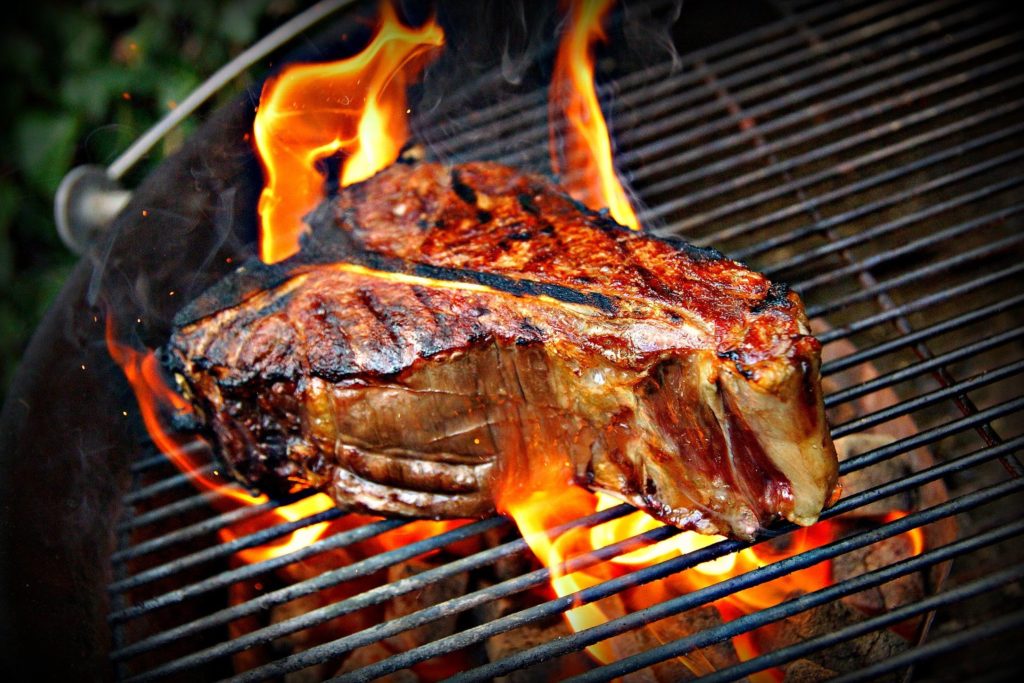Nothin’ Like (Organic) Meat on the Grill
As the Fouth is THE summer holiday weekend, there’s a lot of rays to be caught, beverages to slug, and chow to be chewed, so I’m going to make this short and sweet.
I love meat. It’s hard to argue anything more American than meat on the grill. As a young sport, my Dad once bestowed upon me the words of wisdom (I use this loosely), “more meat, more treat.” I had no idea what this (joke?) meant at the time, and you could interpret it in many different ways depending on context and situation, but I assure you, he’ getting old but definitely not a Bad Grandpa. For the sake of the subject of this Finding, let’s just take it literally: nothing says ‘Merica like meat on the grill on a hot summer, fourth of July weekend (well, maybe this does) — the more, the merrier! I agree with this sentiment.
Meat tastes good and is also good for you, contrary to popular belief. The caveat is that there certainly are varying levels of quality regarding meat. Not only does quality affect taste, but most importantly your long-term health.
 There’s a lot of hoopla in the foot industry. It seems like everything says, “all natural” now and it’s a bunch of malarkey. Because of this, there are skeptics, for good reason, that believes other “health food” terms such as, “organic,” “grass-fed,” “pasture-raised,” is a bunch of B.S. as well — at least not worth the price tag.
There’s a lot of hoopla in the foot industry. It seems like everything says, “all natural” now and it’s a bunch of malarkey. Because of this, there are skeptics, for good reason, that believes other “health food” terms such as, “organic,” “grass-fed,” “pasture-raised,” is a bunch of B.S. as well — at least not worth the price tag.
I found and informative and unbiased article that provides clarification of what “organic” really means and if it’s actually better for you.
My Cliffs Notes version with key takeaways below.
The basics of what the “organic” label really means
Organic livestock must be raised on certified organic land meeting organic crop production standards and any feed must be 100 percent certified organic. Organic ruminants—such as cattle, sheep, and goats—must have free access to organic pasture for the entire grazing season, and 30 percent of their diet must come from organic pasture. Organic practices help to support animal health and are also markedly better from an environmental perspective.
- Per a recent study, Omega-3’s, which reduce inflammation, were 47% higher in organic meat.
- Organic milk also has 69 percent higher alpha-lipoic acid (ALA), 41 percent higher conjugated linoleic acid (CLA), and 57 percent higher omega-3 fatty acids than conventional milk.
- Organic dairy was found to have slightly lower iodine and selenium levels, but higher iron and vitamin E levels. Organic dairy has significantly higher levels of protein than conventional dairy.
- Organic products are also less likely to contain antibiotic-resistant bacteria.
- Antibiotics and grain-feed are commonly used in conventional meat production as a means to promote growth. Ironically, most people never think that the same agents that fatten up meat animals (antibiotics, grains) will likely also cause weight gain in humans.
- Bacterial contamination of meat products occurs at about the same rate in organic and conventional meat, but the risk for isolating bacteria resistant to multiple antibiotics is 33 percent higher in conventional than in organic pork and chicken
- Hormones, such as estrogen and testosterone, are typically implanted in the ear of conventional factory farm animals three months before slaughter to help promote growth. Most of these hormones have been banned in Europe since 1989.
- Organic meat has fewer synthetic pesticides involved in its production, which lends to improved animal health and less environmental impact.
- Pesticides, hormones, and other toxins tend to concentrate in the adipose (fat) tissue. This means that choosing organic may be a particularly wise choice for fattier cuts of meat.
 Putting it all together
Putting it all together
Both organic and non-organic meats are rich in essential nutrients, including protein, zinc, iron, phosphorus, and B vitamins.
Taken as a whole, organic meat tends to have a more favorable fatty acid profile and reduces exposure to antibiotic, hormone, and pesticide residues. In reality, organic or non-organic is just one factor to consider when sourcing animal products for your next meal. Other important considerations include grass-fed vs. grain-fed, source, and cost.
We won’t get into it, but another consideration is the well-being of livestock. It’s brutal how animals are treated in the conventional meat processing industry. They are subject to poor treatment, poor nutrition, poor living conditions. You are what you eat — feel good about it.
I don’t want to be a downer ending on a negative note, so look at this and be proud to be an American (’cause at least you know you’re free)! Enjoy the weekend!
So much for keeping it shorts and sweet…


